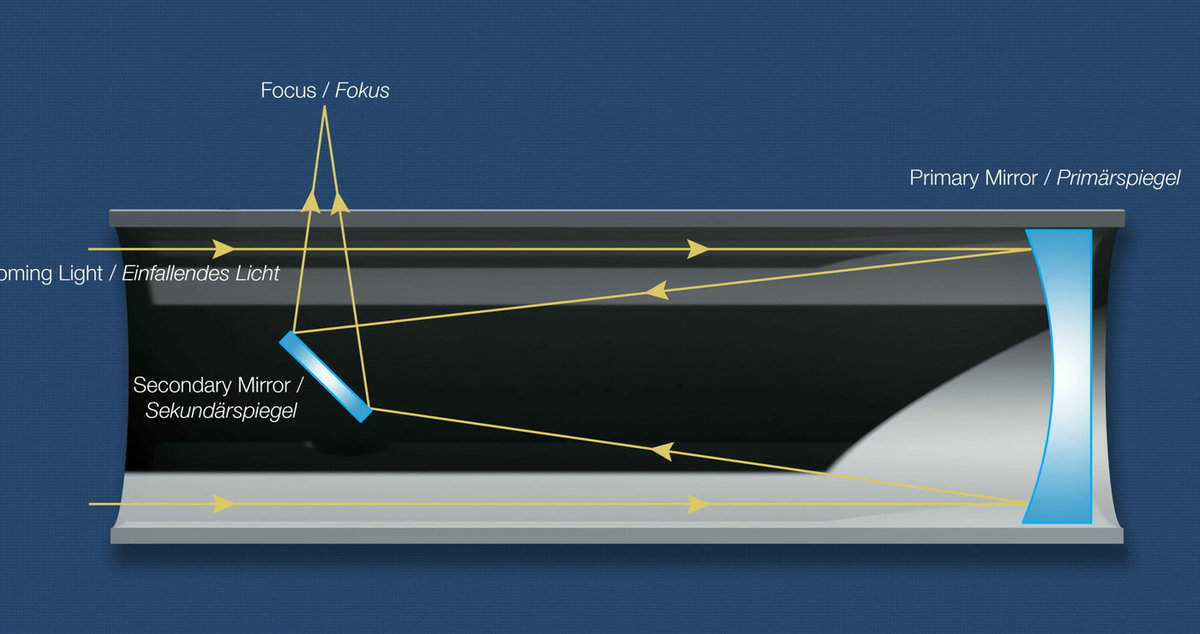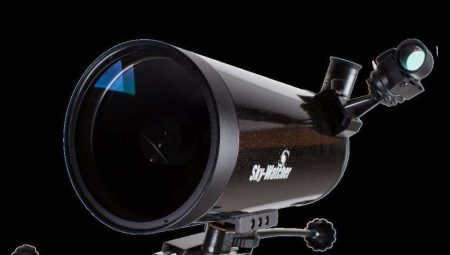
A mirror-lens telescope is a type of optical system that combines reflective and refractive elements. These structures started being used in automobile headlights, lighthouses, as well as microscopes and telescopes. These devices are often referred to as catadioptric telescopes, which distinguishes them from catoptric telescopes by their use of spherical mirrors and inclusion of lenses.
Background
The concept of the mirror-lens telescope was first introduced in 1930 with the intention of combining the superior qualities of reflector and refractor telescopes. The invention was credited to B. Schmidt, an Estonian optician. As the name suggests, these telescopes incorporate both mirrors and lenses to create an image, with the lenses effectively correcting visual aberrations and enhancing the quality of the resulting picture.
While Schmidt was successful in achieving a significant increase in the field of view and light-gathering capacity, the complexity of his mirror-lens apparatus made it challenging to mass-produce, preventing widespread popularity. Nevertheless, further advancements and refinements were made to the device over time, and it is now widely utilized in modern times.
Device and Operation Principle
Catadioptric telescopes employ a rather intricate design. The path of the rays within the tube is traversed multiple times, allowing the device to remain compact even at higher levels of magnification. The configuration of such a telescope includes a combination of lenses and mirrors, which effectively minimizes distortion in the image, enabling clear visualization of the object.
However, there is one caveat – this optical system must be set up in advance at the desired observation location, as variations in air temperature can cause the telescope to malfunction.
Advantages and disadvantages
The benefits of using such a telescope:
- The image quality is exceptionally high, especially at shorter distances.
- It is incredibly user-friendly and easy to operate.
- This telescope does not require any adjustments.
- It offers excellent focusing capabilities, even in a compact size.
- It is relatively compact and portable.
- It has a closed tube design, although it does require thermal stabilization.
- It is suitable for use on a balcony.
- On the downside, it does come with a rather high price tag.
- It lacks thermal stabilization.
- This telescope is only suitable for focusing on planets.
- There may be color distortion when viewing certain objects.
It is important to note that the functioning of all devices is not based on approximation, but on the quantity of light. This implies that everything relies on the size of the light-gathering component, whether it be a lens or a mirror, and if the parameters are optimal, there will be ample light.
In today’s world, telescopes are continuously evolving, allowing for the replacement of bodies, lenses, and mirrors, while still adhering to the same principle. There exists a wide range of mirror-lens telescope models, varying in price range.
Classic in design, mirror-lens telescopes stand out from the rest. These instruments resemble a tripod-mounted telescope, boasting exceptional quality and clarity in their images thanks to the multiple lenses they possess. Typically used for observing the moon, large stars, and planets, they are also suitable for daytime observations. However, their capabilities are limited when it comes to deep space viewing in low light conditions.
How to make a choice?
Catadioptric telescopes are constructed using concave and diagonal mirrors. The manufacturing cost of these telescopes is significantly lower, which affects their design. This cost advantage allows for the purchase of a catadioptric telescope with a larger lens diameter compared to a refractor telescope. These devices with a larger lens are often able to achieve excellent focus on light, making them ideal for observing celestial objects and faint phenomena in space.
- If you are new to astronomy, consider an azimuthal mount telescope.
- Equatorial telescopes are suitable for professional astronomers.
- A reflector telescope is an excellent option.
- For a more in-depth study, consider a refractor telescope.
The mirror telescope is more suitable for experienced and knowledgeable astronomers, as beginners may find it challenging to use due to its angled view. Inexperienced individuals may have difficulty figuring it out.
Top models
When it comes to the best telescope models, each device has its own strengths and advantages. The market offers a variety of types and options. Mirror-lens telescopes are versatile and can be used for various purposes, whether it’s observing from a house or in the open air. All models of these telescopes provide high-quality images and are equipped with reliable optics. Ultimately, the choice depends on personal convenience. Here are some models to consider:
- If you prefer a telescope for quick space observations, the Celestron Astro Fi model is an excellent option;
Welcome to our astronomy discussion board!
We trust that you will find insightful responses to your inquiries about amateur astronomy here, grounded in experience and expertise rather than mere speculation, misinformation, or superficial internet browsing.
If you opt to become a member, we kindly ask that you adhere to these guidelines when contributing to the discussions.
Key Topics: Frequently Asked Questions (FAQs), Reviews of Equipment, and Eyepieces
Rays and Beams in a Telescope
Ernest Founder Posts: 17037 Posted: October 12, 2009, 10:55 pm. Contact info:
The path of rays and beams in a telescope
Message Ernest ” October 18, 2014, 13:07
Diagram of the passage of light through the optics of a telescope
- Ray of light – a vector indicating the direction in which light travels. In an optical medium with uniform properties, light travels in a straight line and changes direction when it encounters the boundaries of other optical media, following the laws of refraction and reflection. A ray of light is perpendicular to the front of light propagation. In diagrams, rays are represented as thin, straight lines with a specific direction. A ray is incredibly thin and, as a result, carries an infinitesimal amount of energy from the light source to the point where this energy is absorbed (for example, at a photodetector).
- A beam of light can be visualized as multiple light beams originating from a single point on the light source, potentially converging to form a single image point. The beam is typically confined in the transverse direction by the outermost rays or aperture rays, and it has a defined cross-sectional area. If the cross-section is symmetrical, the beam may possess a central axis referred to as the main ray. Other rays in the beam, excluding the main and aperture rays, are characterized by their zone – the relative distance from the main ray, either angular or linear. A light beam carries light energy, known as light flux, due to its finite size. In optical systems, aperture diaphragms limit the extent of light beams. When the rays of the beam (or their extensions) intersect, an actual or virtual image of a specific point on the depicted object is formed.
- Optical axis – The axis of rotational symmetry in optical systems known as centered systems. The optical axis is where the centers of curvature of optical surfaces are located, and it intersects all optical surfaces perpendicularly. It serves as the main reference line for measurements in the optical system, with all angles (such as aperture and field) and transverse distances (or elevations) being measured from this axis.
- Apertures – There are three types of apertures: the aperture, which limits the size of light beams coming from an object; the field aperture, which limits the image by cutting off excessive light beams at the narrowest part where actual images are formed; and vignetting, which partially restricts the light beams in the transverse direction.
- Point of the object – a tiny point on an object that emits rays of light.
- Object or the thing being observed is made up of luminous dots.
- Space of the object – all the points that emit light and are represented by the optical system (usually located to the left of the first surface of the optical system as the light travels).
- Point of the image – the point where the rays of light intersect, either physically (where an image receiver can be placed) or theoretically (where the extensions of the rays intersect in the opposite direction).
- Image of the observed object – a collection of image points.
- Image space refers to the collection of all points (both real and imaginary) that make up the images produced by an optical system after light beams pass through its final surface (at the output of the system). Each point in the object space corresponds uniquely to a point in the image space.
- Stray rays/beam are the rays and beams that should not have contributed to the formation of the image. These rays and beams are typically meant to be blocked by diaphragms, absorbed by the body and other parts, scattered by defects in optical surfaces and media, or unintentionally pass through the optical path. However, they still reach the photodetector, resulting in both uniform image illumination and varying degrees of focused glare.
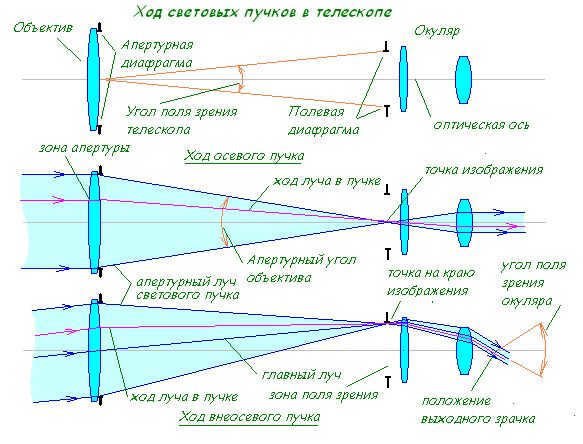

[align=center][/align].
In domestic practice, it is common to illustrate optical diagrams with a cross-sectional view, where light from the objects being depicted comes from the left.
Light is emitted from all points in the object’s space in all directions. The telescope is positioned in front of the object to be observed, with a lens – a unit composed of multiple optical elements (such as lenses and mirrors). The telescope captures only a portion of the light emitted from each point in the object’s space – a beam of light rays (which are practically parallel to each other if the light source is located at “infinity”) – limited by the aperture (or aperture diaphragm) of the telescope. In the diagram, the lens barrel serves as the aperture diaphragm.
Additionally, the light beam undergoes refraction and transitions from being nearly parallel to becoming significantly convergent as it moves towards the field aperture. Near the field diaphragm, individual rays of light converge at specific focal points (each ray having its own), creating an intermediate image. From these points in the intermediate image, the light rays then diverge, much like they would from real objects, but with one key difference – the points in the intermediate image do not emit light in all directions, but rather only within the limits of the light beams defined by the aperture diaphragm on the lens. After passing through the field aperture, the primary light rays have small angles with each other and with the optical axis, effectively remaining almost parallel, or in other words, moving in a telecentric manner.
Additional beams of light are directed towards the optics of the eyepiece. Upon refraction through the eyepiece lens, the light rays emerge from it parallel to other rays within their respective beams (although the beams themselves are no longer necessarily parallel to each other or to the optical axis). All of these light beams, which consist of nearly parallel rays, intersect at the region known as the “exit pupil.” The exit pupil creates the image space. For an observer to see an enlarged image of the objects in space that the telescope is capturing, their eye (specifically, their pupil) must be positioned within the exit pupil of the telescope. This ensures that all of the rays collected by the telescope will enter the eye and contribute to the formation of a real image on the retina (a layer of light-sensitive cells).
- The lens collects a beam of parallel rays from the axial point of an object that is infinitely distant at a point known as the back focus of the lens. The front focus of the eyepiece refers to the point in the intermediate space that satisfies two conditions: (1) it lies on the optical axis and (2) it forms a beam of strictly parallel rays at the exit from the eyepiece.
- To ensure that the light beams, which are made up of parallel rays, can exit the telescope in the same parallel form and create an image that can be viewed by the eye, it is necessary for the rear focus of the objective lens to be aligned with the front focus of the eyepiece. However, there are a few exceptions to consider: (1) for individuals with nearsightedness, the light beams should be slightly divergent when they exit the telescope to compensate for the observer’s myopia; (2) when observing objects that are not at an infinite distance, such as in terrestrial observations, the light beams that enter the telescope are not completely parallel, but rather divergent. In both of these scenarios, a small distance is needed between the back focus of the objective lens and the front focus of the eyepiece.
- An axial light beam is responsible for constructing only one axial point in the image, and it is not sufficient to form a solid image. In order to form the entire image space through the telescope, an infinite number of light beams must pass – the same number as the number of points in the image. All beams, except for the axial beam, which participate in the formation of the image, are referred to as off-axis beams.
- The off-axis beams of light that pass through a centered optical system do not possess rotational symmetry like the axial beam. However, it can be demonstrated that they exhibit strict mirror symmetry with respect to the plane that is drawn through the optical axis and the main ray.
- If we trace the path of the primary rays of off-axis beams, we can observe that they all converge at the intersection of the aperture diaphragm plane with the axis, as well as at the location of the exit pupil at the eyepiece’s exit. In other words, the exit pupil is optically connected to the aperture diaphragm and functions as its image. There are two systems of light beams to consider – the aperture beams, which we have discussed thus far, and a distinct axisymmetric beam formed by the primary rays of off-axis beams. This beam facilitates the optical connection between the entrance and exit apertures, as well as the entrance and exit pupils.
- Off-axis beams that pass through the edge of the field diaphragm (as depicted in the lower portion of the diagram) create an image of the edge or border of the field of view.
- The aperture angle is determined by the angles between the outermost rays of one beam and it determines the convergence of the light beam. The entrance and exit aperture angles are close to zero (in this case, the aperture is more conveniently characterized by the beam diameter). Inside the telescope, the convergence of light beams is a significant design characteristic that determines the level of difficulty in correcting the telescope’s aberrations.
- Stigmatic refers to light beams that consist of rays that are strictly parallel or intersect strictly at one point. Light beams are fully stigmatic only in the space of objects, as they are emitted from a single point of intersection. However, when these light beams pass through optical surfaces, they cease to be stigmatic, as the rays within the beam can intersect with other rays at different points. As a result, the converging rays of the beam may not strictly converge to a single point, leading to deviations from stigmatism known as aberrations.
- There are some complicating factors that do not alter the principles mentioned above.
- Mirror telescopes use reflection to focus light beams, with a central shielding zone where no rays are present. This zone is considered along with the extreme aperture rays and the rays that limit the shielding zone.
- Diagonal mirrors and prisms can be excluded from consideration by reflecting and reducing the optical system while preserving its axisymmetry.
- A Barlow lens, field corrector, or other pre-focal component can be added in front of the eyepiece to slightly adjust the focal points of the eyepiece and lens. This component should be treated as part of the eyepiece or lens to determine their total focus, or a cascade of three or more nodes can be considered to align their focal points.
- Often, the aperture diaphragm is positioned inside the lens, either between its lenses or mirrors. In order to determine the entrance field of view, the concept of the entrance pupil is introduced, which is the virtual image of the aperture diaphragm created by a part of the optical system between the object space and the diaphragm space.
- Astigmatism causes off-axis beams in meridional and sagittal sections to converge at different points known as astigmatic focuses. This is another example of how aberrations affect the aforementioned scheme. The sagittal section is a cross-section of the off-axis beam that is perpendicular to the meridional cross-section and passes through its main ray.
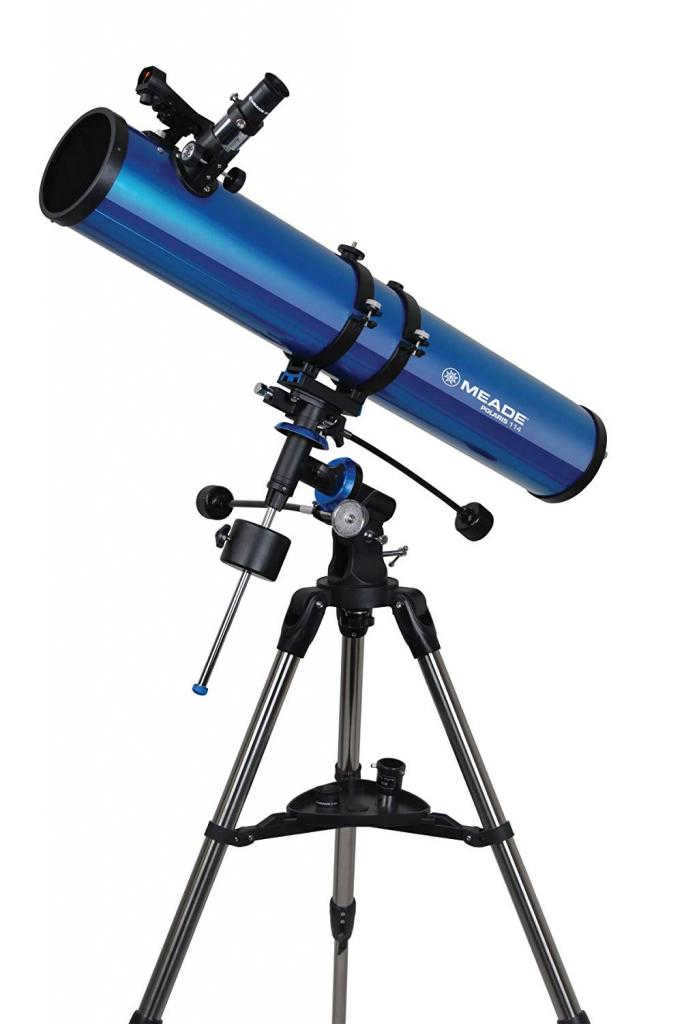
Characterization of reflecting telescopes
The concept that curved mirrors can function like lenses has been recognized for centuries. One of the earliest mentions of this idea can be traced back to Alfazen’s treatise on optics, which was written in the eleventh century and widely circulated in Latin translations during the early modern period in Europe. Building upon this knowledge, Galileo, Giovanni Francesco Sagredo, and other scientists who were familiar with the principles of curved mirrors began to discuss the possibility of constructing a telescope that utilized a mirror as its imaging component. It is believed that the first reflector telescope was built by Cesare Caravaggi, an Italian from Bologna, around 1626. However, Niccolò Zucci, another Italian professor, claimed in a later publication that he had experimented with a concave bronze mirror as early as 1616, although he stated that the image produced was not satisfactory.
History of Creation
There have been numerous proposed designs for future telescopes that aimed to harness the potential advantages of using parabolic mirrors. One of the most notable figures in this field was James Gregory, who introduced an innovative design for a “reflecting” telescope in 1663. However, it wasn’t until ten years later in 1673 that the experimental scientist Robert Hooke was able to successfully construct this type of telescope, which came to be known as the Gregorian Telescope.
In 1668, Isaac Newton is widely credited with being the first to build a reflector-refractor telescope. This telescope utilized a primary mirror made of spherical metal and a small diagonal mirror, and it is now commonly referred to as the Newtonian telescope.
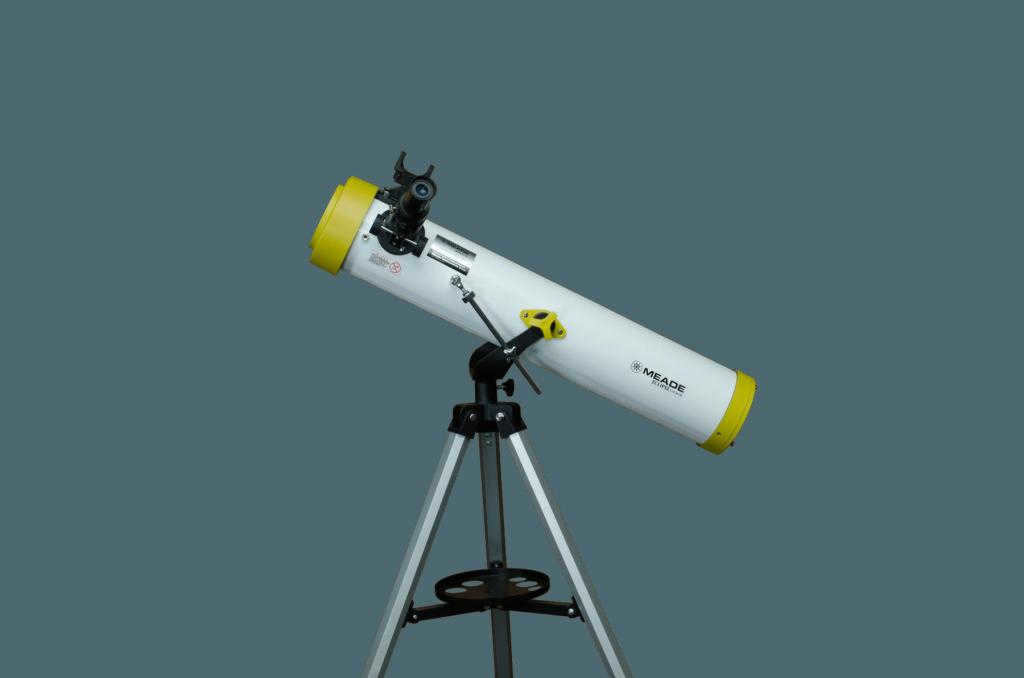

Advancement in the Field
Despite the initial benefits of the reflector design, the challenges in building and the limited performance of the metal mirrors used during that time led to a slow adoption of this technology. It took more than a century for reflector telescopes to gain popularity. Over the years, there have been significant advancements in reflector telescope design. In the 18th century, there were improvements in the fabrication of parabolic mirrors. The 19th century brought the use of silver-coated glass mirrors, which further enhanced the performance. In the 20th century, the introduction of durable aluminum coatings improved the longevity of the mirrors. Another breakthrough was the development of segmented mirrors, which allowed for larger telescope diameters. Additionally, active optics were introduced to compensate for gravitational deformation. A notable innovation in the mid-twentieth century was the catadioptical telescopes, such as the Schmidt camera. These telescopes utilized both a spherical mirror and a lens, known as a corrector plate, as their primary optical elements. They were primarily used for large-scale imaging, avoiding spherical aberration.

The primary component of the telescope is the curved mirror, which is responsible for creating the image at the focal plane. This distance between the mirror and the focal plane is known as the focal length. To capture an image, a digital sensor can be positioned here, or an extra mirror can be included to adjust the optical properties and redirect light towards the film, digital sensor, or eyepiece for visual observation.
Detailed description
Most modern telescopes feature a solid glass cylinder as their primary mirror. The front surface of this cylinder is shaped either spherically or parabolically. To create a mirror that reflects light, a thin layer of aluminum is applied to the lens using a vacuum process.
There are also telescopes that utilize primary mirrors made in a different way. In this method, the molten glass is rotated to give it a paraboloidal shape. Once the glass cools and hardens, it forms a mirror with an approximation of the desired paraboloidal shape. This technique requires minimal grinding and polishing to achieve the desired accurate figure.
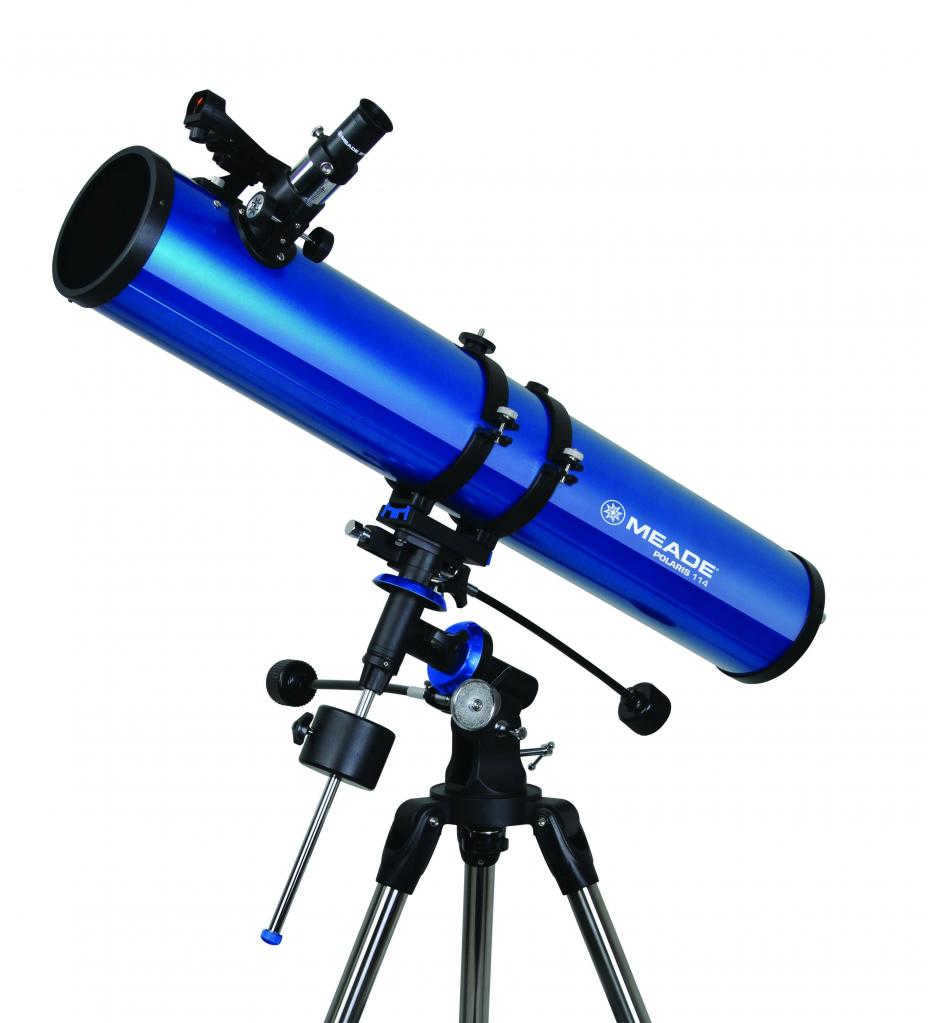
Quality of the Image
Similar to all other optical systems, reflector telescopes do not generate images that are completely flawless. The necessity to capture photographs of objects located at distances that extend to infinity, to observe them using various wavelengths of light, and the requirement to have a method of viewing the image produced by the main mirror, all result in certain compromises in the optical design of a reflecting telescope.
Since the primary mirror concentrates light to a central point in front of its reflective surface, almost all designs of reflecting telescopes incorporate a secondary mirror, film holder, or detector near this point, which partially obstructs the light from reaching the primary mirror. This not only leads to a decrease in the amount of light collected by the system, but also causes a reduction in image contrast due to diffraction obstruction effects, along with diffraction spikes caused by the majority of secondary support structures.
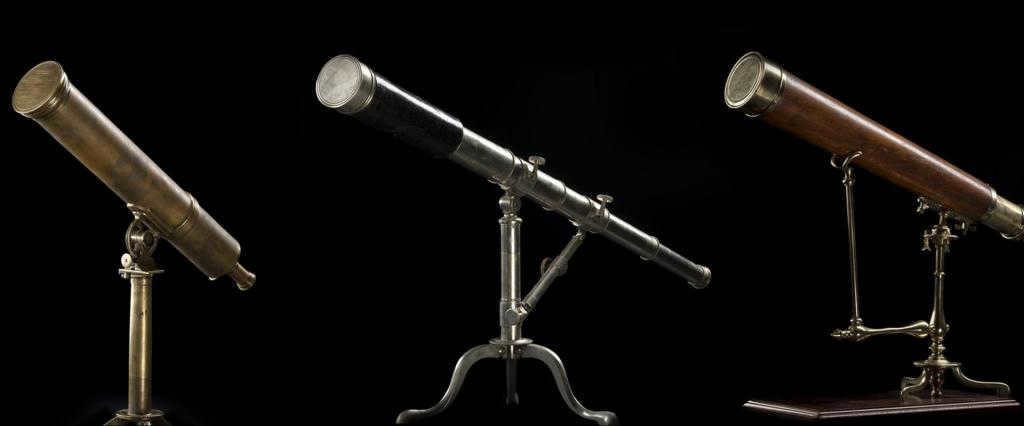
Mirrors are employed to prevent chromatic aberration, although they give rise to other forms of aberrations. A basic spherical mirror is unable to converge light rays from a distant object to a single focus due to the fact that the reflected rays from the edge of the mirror do not converge with those from the center. This flaw is known as spherical aberration. To overcome this issue, state-of-the-art reflector telescopes employ parabolic mirrors that can bring all the light to a single focus.
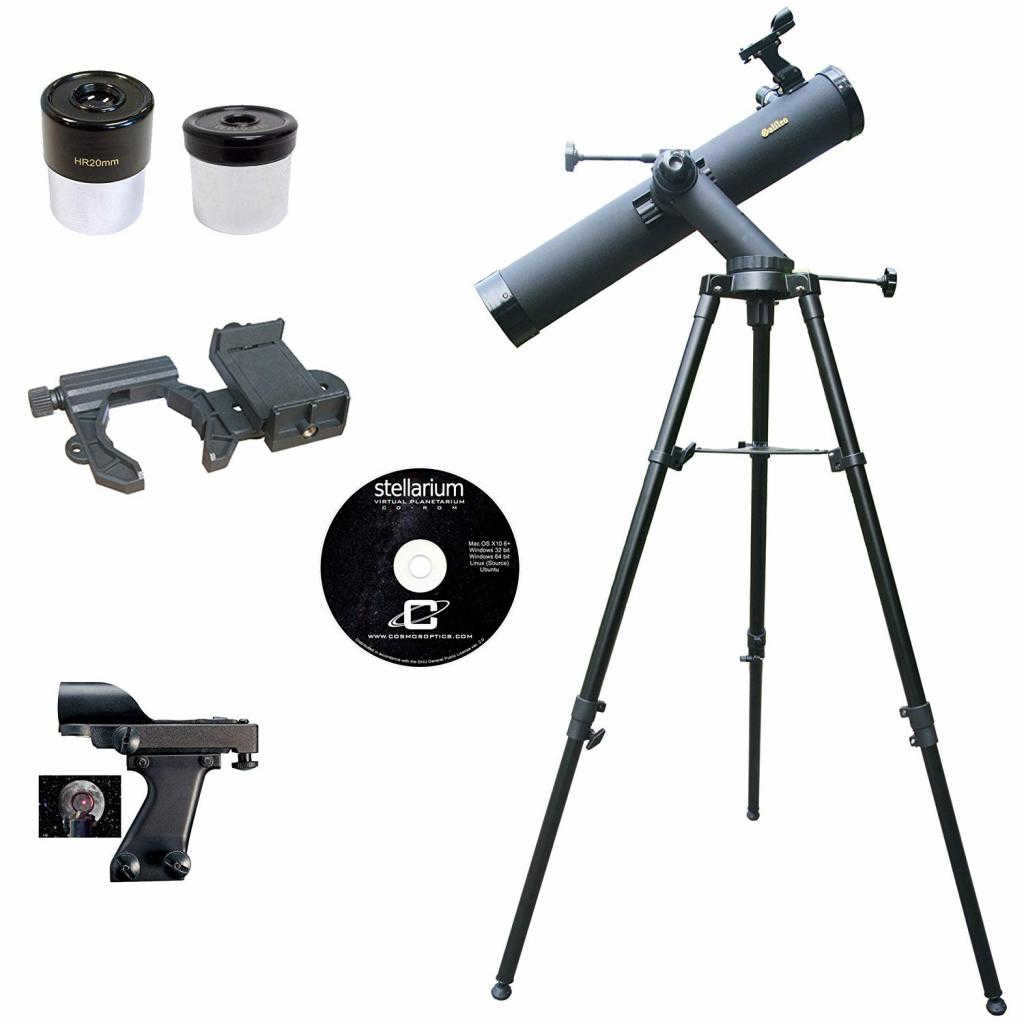
Gregorian telescope
In his 1663 book Optica Promota, Scottish astronomer and mathematician James Gregory describes the Gregorian telescope as employing a secondary mirror that is concave and reflects an image through a hole in the primary mirror. This results in the creation of a vertical image that is beneficial for observations conducted on the ground. There are numerous contemporary telescopes of considerable size that employ the Gregorian configuration.
Newton Reflector Telescope
The Newtonian Reflector Telescope, invented by Isaac Newton in 1668, was the first successful reflecting telescope. This type of telescope typically features a paraboloidal primary mirror, although for focal ratios of f/8 or higher, a spherical primary mirror may be used, which can still provide high visual resolution. The light is reflected by a flat secondary mirror onto the focal plane located at the top of the telescope tube. The Newtonian design is known for its simplicity and affordability, making it a popular choice among amateur astronomers. The principles behind the ray tracing of reflector telescopes were first developed for the Newtonian design.
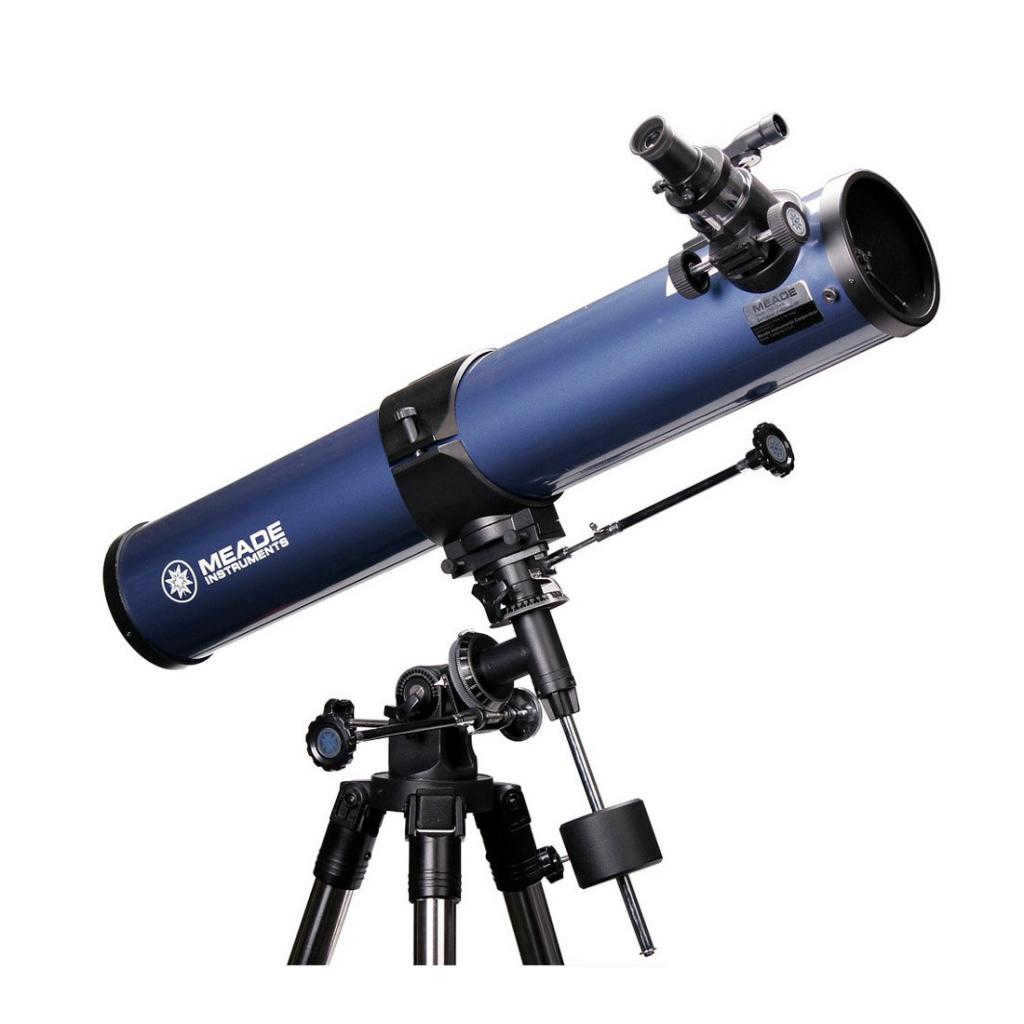
The Cassegrain Telescope
The Cassegrain telescope, also known as the “classic Cassegrain,” was initially built in 1672 by Laurent Cassegrain. This telescope features a primary mirror with a parabolic shape and a secondary mirror with a hyperbolic shape. The secondary mirror reflects light downwards and through an opening in the primary mirror.
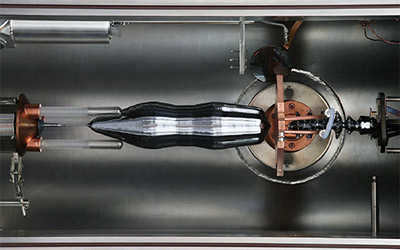
The upcoming Kilogram Standard
has the potential to replace the outdated platinum-iridium version."""
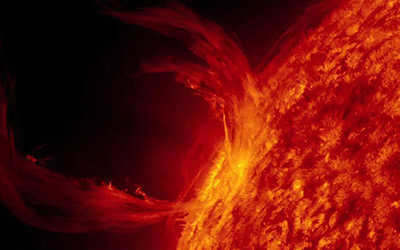
The Sun Approaching
We have acquired high-quality pictures of the Sun captured by the Solar Dynamics Observatory in space. """

The Genius Who Bent Time
An in-depth look into the life of Albert Einstein, the brilliant physicist who revolutionized our understanding of time and space with his groundbreaking theory of general relativity.
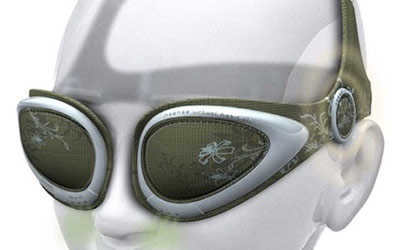
What are the Future Glasses?
Explore the origins, advancements, and potential of the revolutionary eyewear.
Telescopes serve the purpose of enlarging distant images. Objects that are far away may appear minuscule to the naked eye due to their small angle of visibility. There are two primary categories of telescopes: refractor telescopes, which employ lenses, and reflector telescopes, which utilize mirrors.
Refractor telescopes
In a refractor telescope, multiple lenses are utilized.
A basic astronomical telescope can be constructed using two collecting lenses with different focal lengths. The objective lens, denoted as f0, has a long focal length, while the eyepiece lens, denoted as fe, has a shorter focal length. The angular magnification, M, of this telescope when pointed normally is given by M = f0/fe. The magnification is highest when f0 is maximized and fe is minimized.
However, there are practical limitations to how short fe can be without causing disruption to the overall image. The objective lens must have a large aperture (diameter) to gather the maximum amount of light. This results in the objective lens being heavy, expensive, and challenging to grind precisely.
The determination of angular magnification involves the comparison of the size of an image observed through an optical device with the size of an object viewed with the unaided eye. Angular magnification is defined as the ratio of the angles β/α, where β represents the angle at which the object is visible through the entire instrument and α represents the angle at which the objective lens can perceive the object. It should be noted that this comparison is made more accurately with the naked eye, although the length of the telescope is considered negligible in relation to the distance to the object.
The diagram illustrates the path of rays and the creation of a visual representation in an astronomical telescope. It depicts two sets of parallel rays originating from the top edge T and the bottom edge B of a star or planet. These rays converge to form an inverted real image of B1Т1 on the focal plane of the objective lens. This actual image is observed through a short focal length eyepiece lens functioning as a magnifying glass. Once the image aligns with the focal plane of the eyepiece lens, all rays exiting the eyepiece become parallel to the dashed line T1Ое, resulting in the final image being at an infinite distance.
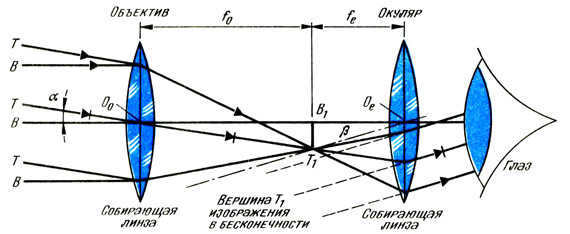
When you look at the image, it helps to reduce eye strain. The image itself appears upside down, but this isn’t a problem when you’re looking at cosmic objects. You can add another lens to the telescope to make the image appear right-side up, but this will make the telescope longer by four times the focal length of the flipping lens.
The distance between the two lenses is usually the sum of the focal lengths of the objective and eyepiece lenses (f0 + fe). You can create a model telescope with an objective lens that has a focal length of 30 cm and an eyepiece lens with a focal length of 2.5 cm, positioned 32.5 cm apart. The largest refractor telescope with an aperture of 100 cm is located in Wisconsin, USA.
Galileo’s telescope and prismatic binoculars
An alternative way to obtain the ultimate visual representation is through the utilization of the remarkable Galileo telescope (also known as theater binoculars). In this particular design, the eyepiece is comprised of a dispersing lens. Similar to the previous example, a converging lens with a significant focal length is employed as the objective lens. It would generate a proper inverted image at point I if the light were not intercepted by the diminutive focal length scattering lens employed as the eyepiece.
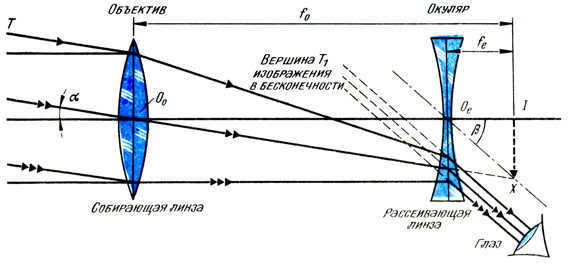
The eyepiece lens is positioned in such a way that the distance OеI is equal to the focal length fe of the eyepiece lens. Consequently, all rays exit parallel to OeX, producing a secondary direct image at infinity. The distance between the two lenses is numerically equivalent to the difference between their focal lengths (f0 – fe). The angular magnification M = β/α, as mentioned previously, is f0/fe. By using a scattering lens, a direct image can be obtained without any loss in magnification with a shorter telescope. However, the main drawback of this arrangement is the narrow field of view, similar to looking through a narrow tube.
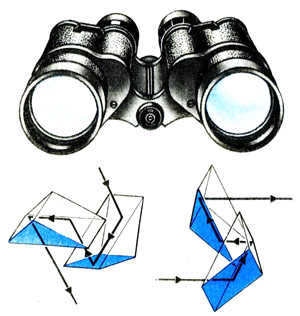
Previously, we discussed one method of converting an astronomical telescope with an inverted image into a straight-image telescope by incorporating an additional lens. However, a much more practical solution involves utilizing two isosceles rectangular prisms to flip the image produced by two collecting lenses. In the case of prismatic binoculars, these prisms are positioned at right angles to each other, with their long edges partially touching. The image created by the objective lens is initially inverted and mirror reversed. One prism then further flips the image, resulting in a straight view when observed through an eyepiece functioning as a simple microscope.
Another prism is used to correct the mirror reversal of the image. There are several advantages of using binoculars instead of telescopes:
- The image is displayed in a direct manner;
- The image is not reversed when using a reflector telescope.
- The overall length of a reflector telescope is reduced by 2/3 when prisms are used.
- Reflector telescopes have two telescopes placed next to each other, one for each eye, allowing for depth and perspective perception.
- Reflector telescopes have a wide field of view.
Reflector telescopes
The second type of telescope is the reflector telescope. An astronomical reflector telescope is made up of a large concave (collecting) mirror that is mounted in a frame with a small flat mirror placed closer to the concave mirror than the focus F. The convex (collecting) lens is positioned so that the image in the flat mirror can be viewed through it.
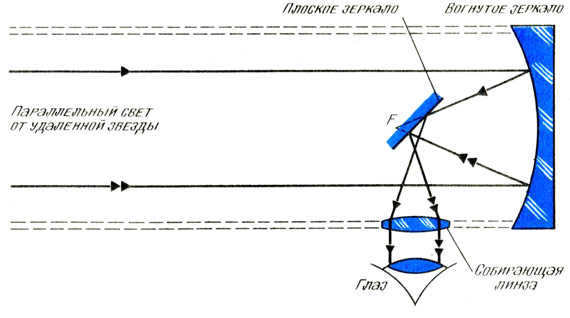
What is the advantage of using a mirror instead of a lens? Mirrors offer a more cost-effective and simpler manufacturing process compared to lenses, and they are also less prone to cracking. Additionally, mirrors are lighter in weight compared to their lens counterparts, making them easier to suspend. Reflecting telescopes, such as the famous 500 cm reflector telescope at Mount Palomar, USA, are renowned for being the largest astronomical telescopes.
Radio telescope
A radio telescope is a different kind of telescope that gathers energy and focuses it at a specific point. Unlike optical telescopes, it doesn’t use visible light. Instead, it has a parabolic “dish” that reflects weak radio signals to a sensitive antenna located at the focal point of the dish. Radio telescopes are used to detect radiation from outer space, as well as for space communication.
Reflecting telescopes, on the other hand, can have various types of optical abnormalities, but they are designed to handle larger targets. Most of the major telescopes used in astronomical research are reflecting telescopes. They come in different designs and may incorporate additional optical components to enhance image quality or optimize the position of the image.
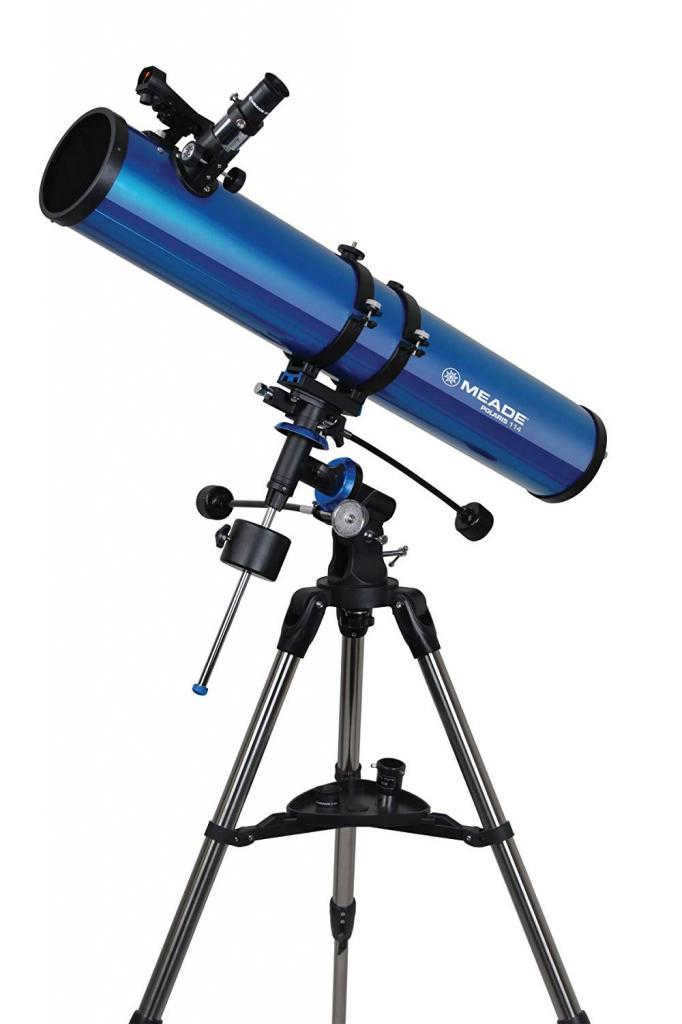
Reflection Telescopes: A Study of Their Characteristics
The concept that curved mirrors can function similarly to lenses has been around since at least the eleventh-century treatise on optics by Alfazen. This work was widely circulated in Latin translations during early modern Europe. Shortly after the creation of the refracting telescope, Galileo, Giovanni Francesco Sagredo, and others, drawing from their understanding of curved mirror principles, discussed the possibility of constructing a telescope that utilized a mirror as its imaging device. It was reported that Bolognese Cesare Caravaggi constructed the first reflecting telescope around 1626. However, Italian professor Niccolò Zucci stated in a later publication that he experimented with a concave bronze mirror in 1616 but found the resulting image to be unsatisfactory.
Origin of Telescope Designs
The concept of utilizing parabolic mirrors to eliminate spherical aberration while avoiding chromatic aberration led to numerous proposals for future telescopes. One of the most significant contributions came from James Gregory, who introduced a groundbreaking design for a “reflecting” telescope in 1663. However, it wasn’t until 1673 that experimental scientist Robert Hooke successfully constructed the Gregorian Telescope based on Gregory’s design.
Credited with the creation of the first reflector-refractor telescope in 1668, Isaac Newton played a vital role in the development of telescope designs. Newton’s telescope featured a primary mirror composed of spherical metal and a small diagonal mirror, establishing the foundation for what is now known as the Newtonian telescope.
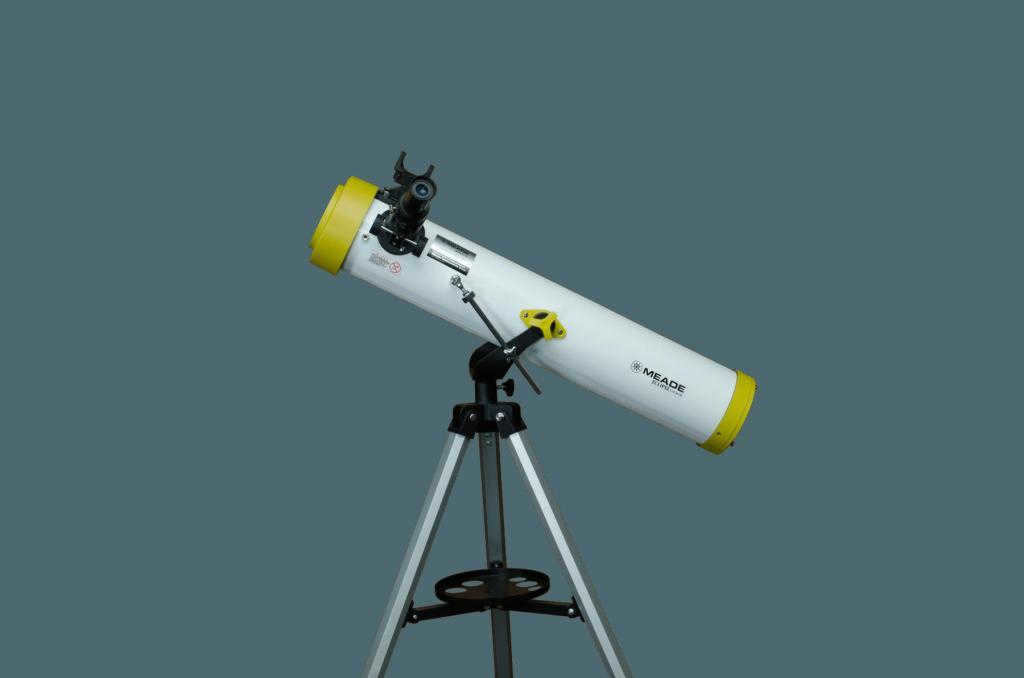
Advancement in the Future
During the latter part of the 20th century, the advancement of adaptive optics and the effective utilization of imaging techniques in order to overcome issues related to observation and the reflection of telescopes have become commonplace in space telescopes as well as various types of spacecraft imaging instruments.
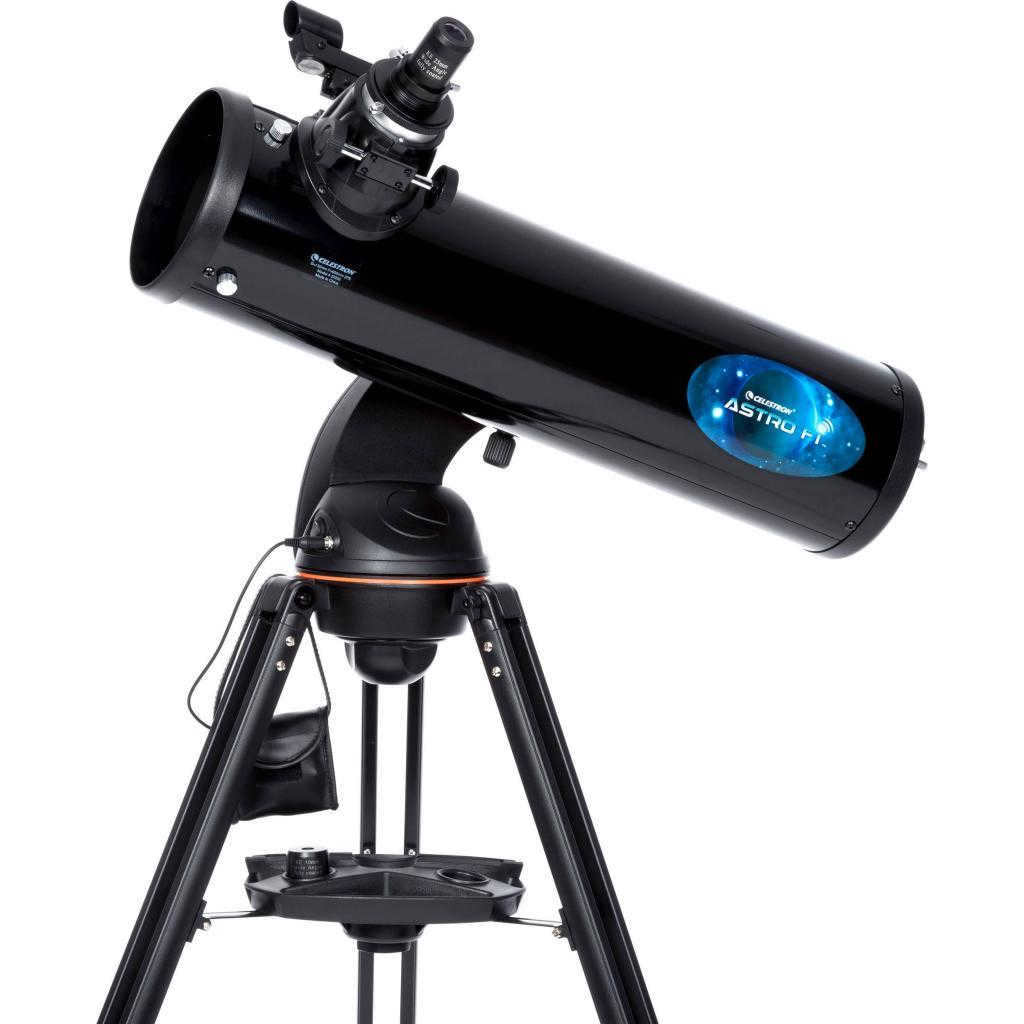
The primary mirror, which is curved, is the key component of the telescope and is responsible for creating the image at the focal plane. The focal length, which refers to the distance between the mirror and the focal plane, plays a crucial role in this process. Depending on the desired outcome, a digital sensor can be incorporated to capture the image, or an additional mirror can be introduced to modify the optical properties and redirect light towards the film, digital sensor, or eyepiece for visual observation.
Detailed description
The main component of most modern telescopes is a solid glass cylinder that has been shaped into a spherical or parabolic form on its front surface. To create a mirror that reflects light, a thin layer of aluminum is applied to the lens using a vacuum.
Other telescopes utilize primary mirrors that are manufactured in a different way. The molten glass is spun to create a paraboloidal surface, which then cools and hardens. The resulting mirror closely approximates the desired shape, requiring only minimal grinding and polishing to achieve the desired accuracy.
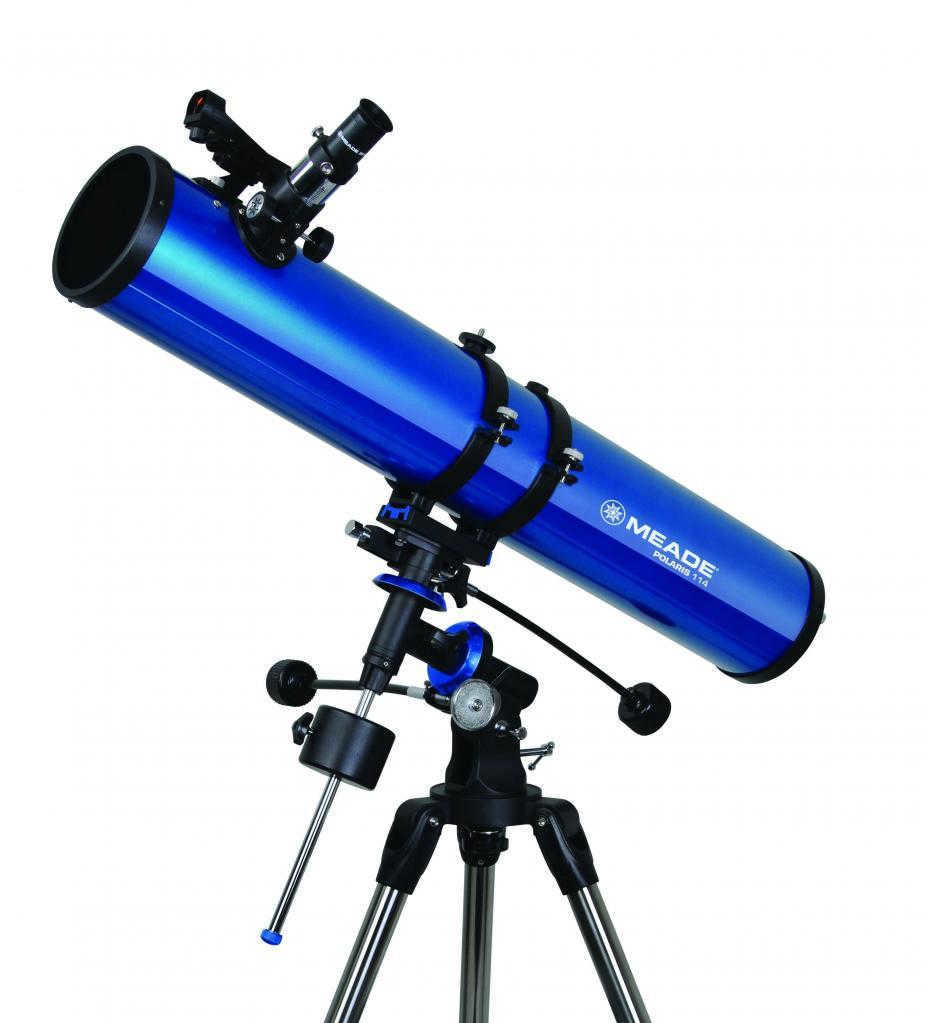
Quality of Images
Reflector telescopes, similar to other optical systems, do not generate images that are “flawless”. The necessity to capture photographs of objects located at infinite distances, to observe them using various wavelengths of light, and the need to have a method of viewing the image produced by the main mirror, all result in some level of compromise in the optical configuration of a reflecting telescope.
Due to the fact that the primary mirror concentrates light towards a central point in front of its own reflective surface, the majority of reflecting telescope designs incorporate a secondary mirror, film holder, or detector near this focal point. This arrangement serves to partially obstruct light from reaching the primary mirror. Consequently, not only is there a reduction in the amount of light collected by the system, but there is also a decrease in image contrast due to the effects of diffraction obstruction and the presence of diffraction spikes caused by most secondary support structures.
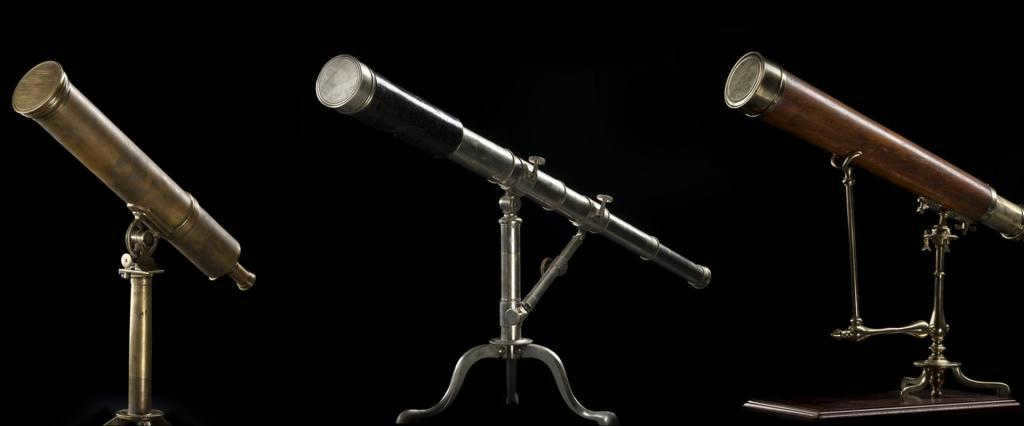
Using mirrors eliminates chromatic aberration, but it introduces other types of aberrations. A basic spherical mirror cannot bring light from a distant object to a single focal point because the reflection of light rays that strike the mirror’s edge do not converge with those that reflect from the center of the mirror. This flaw is known as spherical aberration. To overcome this issue, advanced reflector telescopes employ parabolic mirrors that can bring all the light to a single focal point.
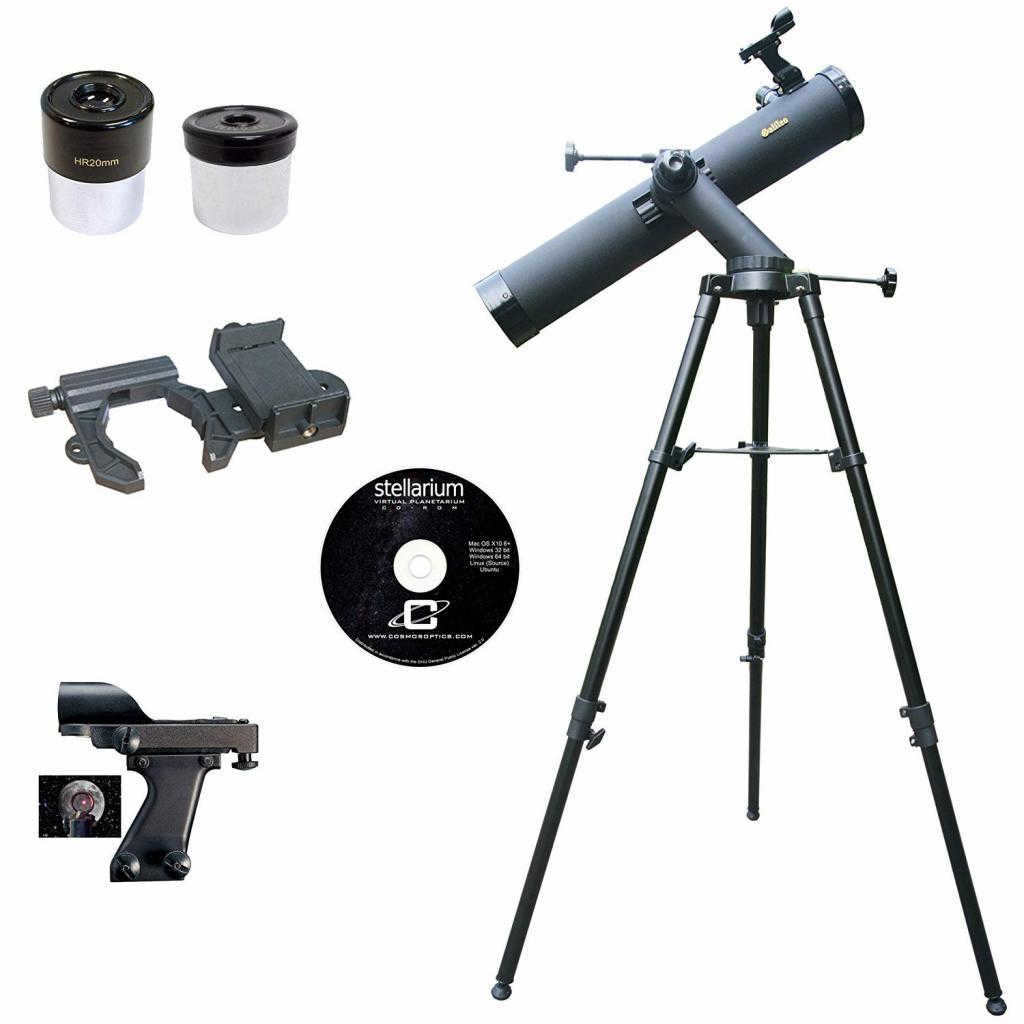
Gregorian telescope
Scottish astronomer and mathematician James Gregory described the Gregorian telescope in his 1663 book Optica Promota. It utilizes a concave secondary mirror that reflects an image through a hole in the primary mirror, resulting in a vertical image that is beneficial for observations conducted on the ground. Numerous contemporary telescopes employ the Gregorian configuration.
The Newton apparatus, created by Isaac in 1668, was the pioneering reflective telescope. Typically, it features a paraboloidal primary mirror, although a spherical primary mirror can be used for focal ratios of f/8 or higher, which is often adequate for achieving high visual resolution. Positioned at the top of the telescope tube, the flat secondary mirror reflects light onto the focal plane. This design is one of the simplest and most cost-effective options for telescopes of this size and is commonly used by amateur astronomers. The principles behind the reflection of rays in reflector telescopes were first developed specifically for the Newtonian design.
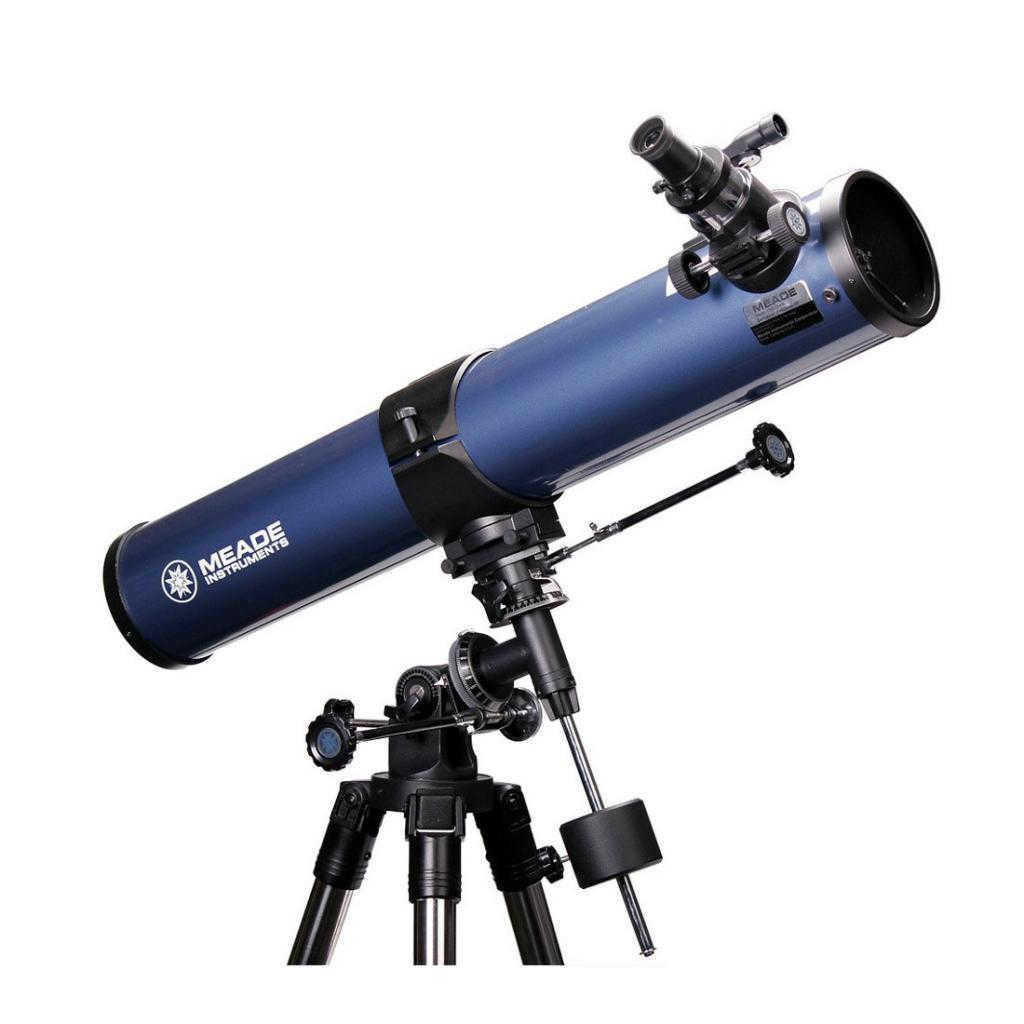
Cassegrain device
The Cassegrain optical instrument (occasionally referred to as the “classic Cassegrain”) was initially fabricated in 1672, credited to Laurent Cassegrain. It features a parabolic main mirror and a hyperbolic secondary mirror that reflects light back and downwards through an opening in the main mirror.

